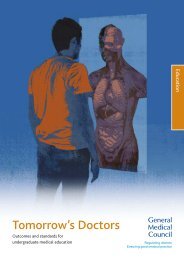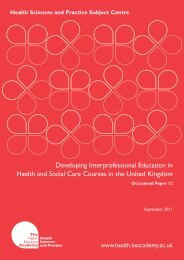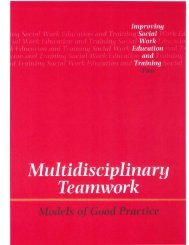Health and Social Care Policy and the Interprofessional ... - CAIPE
Health and Social Care Policy and the Interprofessional ... - CAIPE
Health and Social Care Policy and the Interprofessional ... - CAIPE
Create successful ePaper yourself
Turn your PDF publications into a flip-book with our unique Google optimized e-Paper software.
Similarly, in <strong>the</strong> NSF for coronary heart disease (DH, 2000c) <strong>the</strong>re is<br />
reference to 'collaboration' of <strong>the</strong> numerous individuals involved in this area of<br />
care. In order to achieve <strong>the</strong> goals set out in <strong>the</strong> NSF for diabetes, services<br />
need to be 'integrated' <strong>and</strong> include 'health <strong>and</strong> social care professionals<br />
across a multidisciplinary diabetes health care team, including primary care<br />
<strong>and</strong> social care as well as specialist services' (DH, 2001a: 14).<br />
In 2001, with <strong>the</strong> publication of <strong>the</strong> NSF for older people, a single assessment<br />
process was advocated along with a recommendation that older people<br />
receive 'appropriate <strong>and</strong> timely packages of care… regardless of health <strong>and</strong><br />
social services boundaries' (DH, 2001b). The NSF has identified four core<br />
principles for those caring for older people. These are: to respect <strong>the</strong><br />
individual; deliver joined up care; ensure that everyone is able to access<br />
specialist care when <strong>the</strong>y need it <strong>and</strong> to promote healthy <strong>and</strong> active living.<br />
The NSF also places a strong emphasis on <strong>the</strong> need to integrate care for<br />
older people through closer co-operation across boundaries <strong>and</strong> through <strong>the</strong><br />
development of agreed pathways.<br />
In <strong>the</strong> Children's NSF <strong>the</strong> government advocated <strong>the</strong> development of<br />
'Children's Trusts' where <strong>the</strong> planning, commissioning <strong>and</strong> delivery of health,<br />
education <strong>and</strong> social care services, along with o<strong>the</strong>r relevant agencies would<br />
be coordinated <strong>and</strong> integrated. It also highlighted <strong>the</strong> need for co-location of<br />
services, a common core of training for <strong>the</strong> workforce, <strong>the</strong> use of a lead<br />
professional, integrated commissioning, a common assessment process,<br />
pooled resources, <strong>the</strong> sharing of information <strong>and</strong> robust inter-agency<br />
governance arrangements (DH, 2004a). The Children’s NSF perhaps has <strong>the</strong><br />
most far reaching consequences of all in that it prescribes an interagency<br />
interprofessional model encompassing health, education <strong>and</strong> care for all<br />
children <strong>and</strong> young people. Implementation of this NSF has been rapid <strong>and</strong><br />
<strong>the</strong> evidence of its effectiveness is just beginning to emerge.<br />
The renal NSF (DH, 2004b; 2005a) promoted 'renal services health<br />
communities' which enable all stakeholders, including service users, to take<br />
ownership. It was highlighted that such communities would promote 'work<br />
across traditional service boundaries <strong>and</strong> models of care' to provide seamless<br />
care (DH, 2004b: 11). Closer working between health <strong>and</strong> social services was<br />
echoed in <strong>the</strong> NSF for long-term neurological conditions along with <strong>the</strong> need<br />
for a 'holistic, integrated, interdisciplinary approach to care planning, review<br />
<strong>and</strong> service delivery involving a range of agencies' (DH, 2005b: 13).<br />
The Wanless Report<br />
In 2001 Derek Wanless was appointed by <strong>the</strong> Chancellor of <strong>the</strong> Exchequer to<br />
undertake a long-term view of <strong>the</strong> future health of <strong>the</strong> UK. His brief was to<br />
examine emerging trends <strong>and</strong> identify <strong>the</strong> resources required to ensure that<br />
<strong>the</strong> NHS remained a ‘publicly funded, comprehensive, high quality service<br />
available on <strong>the</strong> basis of clinical need <strong>and</strong> not ability to pay’ (HM Treasury<br />
2001: 1).<br />
34













